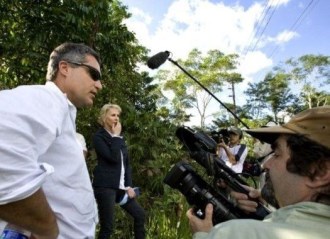

Panama Canal, Chevron Lawsuit, Cuba
Latinvex singles out the key events in Latin America business the past decade.
BY LATINVEX STAFF
The historic Panama Canal expansion, the $8.6 billion Ecuador lawsuit against Chevron and the thaw in US-Cuba relations and subsequent deterioration made the list of key events in Latin America the past decade.
PANAMA CANAL EXPANSION
In June 2016, the Panama Canal inaugurated its expanded $5.4 billion waterway.
The new waterway doubled the Panama Canal’s capacity and could lead to a 50 percent increase in tonnage by 2025, according to projections from the Panama Canal Authority (ACP).
While the expansion was marred by cost overruns and delays, experts said the first anniversary exceeded expectations, with record revenues and traffic.
“The performance of the new set of locks after one year has exceeded most expectations,” says Richard Wainio, a former planning director of the Panama Canal Commission who recently served as Port of Tampa CEO and follows canal development closely.
Panama Canal tonnage has increased by 22.2 percent, when comparing the 2016 and 2017 fiscal year and more than 1,500 Neopanamax vessels have transited the expanded canal, the Panama Canal Authority (ACP) says. Containerships represent approximately 51.3 percent of traffic through the expanded canal, followed by LPG and liquefied natural gas (LNG) carriers, which represent approximately 31.5 and 9.1 percent, respectively.
The expanded canal helped increase revenues for the agency that runs it, helped boost Panama’s GDP growth – already among the leaders in Latin America — and improve the country’s sovereign rating.
“The Expansion Program is truly an innovative and landmark project,” Shearman & Sterling partner Cynthia Urda Kassis said in a statement. Shearman advised ACP on the complex $2.3 billion loan transaction that partially financed the new locks as well as the $450 million bond offering to finance a new bridge crossing the Atlantic end of the Canal.
The Panama Canal was opened in 1914 and is considered one of the world’s leading engineering marvels, basically using the same concept and technology from its opening until today. “It became one of the world’s most significant and massive engineering feats, with enough earth removed to circle the earth four times at the equator in railroad cars,” former Panama Canal Commission Chairman Robert McMillan writes in his book Global Passage.
The ACP has been running the canal since the United States – which built the waterway – handed it over to Panama in 1999. Previously, the canal was run by the Panama Canal Commission, a US agency.
Experts see the clear value of the newly expanded canal.
“The expanded Canal is a game changer for the world economy and without any doubt will offer real competition for the Suez Canal,” McMillan says.
CHEVRON VICTORY AGAINST ECUADOR LAWSUIT
This month, the Second Circuit upheld criminal contempt conviction and six-month sentence of attorney Steven Donziger for not complying with court orders in a fraud and racketeering case involving Chevron Corp.’s operations in Ecuador and the $8.6 billion judgment Donziger won against the company, Bloomberg reported.
As Latinvex previously has stated, the Chevron Ecuador case is a fascinating story of lies, damned lies and statistics mixed with parallels to David versus Goliath and Erin Brockovitch. Except that in this case, David is the bad guy and certainly no Erin Brockovitch.
The “David” in question is Donziger, a US activist lawyer who has stopped at nothing to achieve his goal of getting Chevron to pay billions of dollars for environmental damage in Ecuador.
In March 2014, a US judge revealed just how far Donziger had gone. U.S. District Judge Lewis Kaplan ruled that a $9.5 billion verdict in Lagro Agrio in Ecuador against Chevron was based in fraud. “The decision in the Lago Agrio case was obtained by corrupt means,” he said. “The defendants here may not be allowed to benefit from that in any way.”
“I’ve never seen anything like it in my 33 years as a lawyer and public prosecutor,” Randy Mastro, Co-Chair of the Litigation Practice Group at Gibson Dunn and a former federal prosecutor who gained prominence pursuing mobsters in New York, told Latinvex before the trial ended. “It’s really the brazenness, the audaciousness of the conduct, and then to take the false narrative created in Ecuador and trumpet it in the US, to shake down a US company.”
Business leaders and experts had hailed Chevron’s efforts to fight the lawsuit.
“The conclusion that the Ecuadorian lawsuit against Chevron was fraudulent has been well documented, and it has been confirmed in the judgment of the international investment community, which sees now that Ecuador is not a safe place to invest,” Jodi Hanson Bond, Vice President for the Americas, U.S. Chamber of Commerce, told Latinvex in 2013.
Many foreign investors were quietly cheering on Chevron’s efforts to uncover the truth behind the questionable legal judgments they have faced in Ecuador, said John Price, Managing Director, Americas Market Intelligence.
“If their efforts help dissuade other opportunists from pursuing frivolous legal cases against investors, then the future of foreign investment and technology transfer into Latin America will be much brighter,” he said.
That has meant spending a small fortune on external lawyers and experts as well as internal re-allocation of resources.
“I doubt any other US multinational in Latin America has come anywhere near what Chevron has spent on attorneys, investigators and media consultants,” said Simon Strong, president of Tenacitas International and an expert on Andean affairs. “But Chevron is on the hook for an enormous sum and the current Ecuadorian government has its friends. I think it very unlikely the Ecuadorians’ claim will prosper in the US but some countries … view it sympathetically and will pressure their courts accordingly to freeze Chevron assets. So Chevron has had no choice but to fight what has become a global battle, on all fronts.”
Bond agrees. “This must be the costliest fight of its kind, but it’s part of an unfortunate trend of the U.S. plaintiffs’ bar trying to go global,” she says.
CUBA & US: THAW, THEN FREEZE
In March 2016, President Barack Obama visited Cuba – the first visit by a US president in more than 88 years. The visit marked the highlight of his efforts to improve US relations with Cuba, including lifting several restrictions on business and trade with the island, albeit short of lifting the actual embargo.
The result was an increase in US travel connections, including through airlines and cruise ships, while US hotel chains like Starwood opened a Four Points by Sheraton in capital Havana – the first US hotel top open in Cuba in nearly 60 years.
Carnival Fathom’s 704-passenger Adonia luxury cruise ship arrived in Cuban capital Havana on May 2, 2016 — the first cruise from the US to Cuba in more than 50 years, while an American Airlines flight on November 28, 2017 became the first scheduled commercial flight between the US and Cuba in 50 years.
Michael Shifter, who had been president of The Inter-American Dialogue for 12 years (from 2010 to this year) singled out the opening with Cuba as the single most positive development during his time.
“The biggest surprise was the rapprochement between the United States and Cuba announced on December 17, 2014,” he told Latinvex. “I happened to be in Havana attending a conference on US-Cuba relations, and I can attest that none of the expert speakers, US or Cuban, even hinted that such a policy breakthrough was in the offing. I was thrilled when I heard the news, as I had always advocated for a US policy of engagement with Cuba and was convinced, as President Obama put it, that the longstanding punitive approach was counterproductive and only worsened conditions for the Cuban people.”
However, Obama’s successor Donald Trump moved quickly to undo the thaw.
He prohibited travel to Cuba – thus hurting cruise lines and US airlines bringing passengers to the island – and imposed harsh restrictions on badly needed remittances.
The Trump Administration also broke with tradition and allowed lawsuits to proceed under the so called Title III of the HelmsBurton Act. Title III allows US nationals to file suit in US federal court against persons “trafficking” in property “confiscated” by the Cuban government.
The result? A wave of lawsuits against American Airlines, Amazon, Carnival Cruise Lines (which had been upbeat about its business before Trump became president) and others. In fact, during the six months after the activation of Title III, there were a total of 20 lawsuits by 72 plaintiffs against 67 defendants, according to an overview by John Kavulich, President of the U.S.-Cuba Trade and Economic Council.
President Joe Biden announced in May that it would lift restrictions on travel and remittances, but will likely not follow the Obama-era thaw.
© Copyright Latinvex
Latin America: The Top Events Past Decade
Brazil: The Top Events Past Decade
Mexico: The Top Events Past Decade












